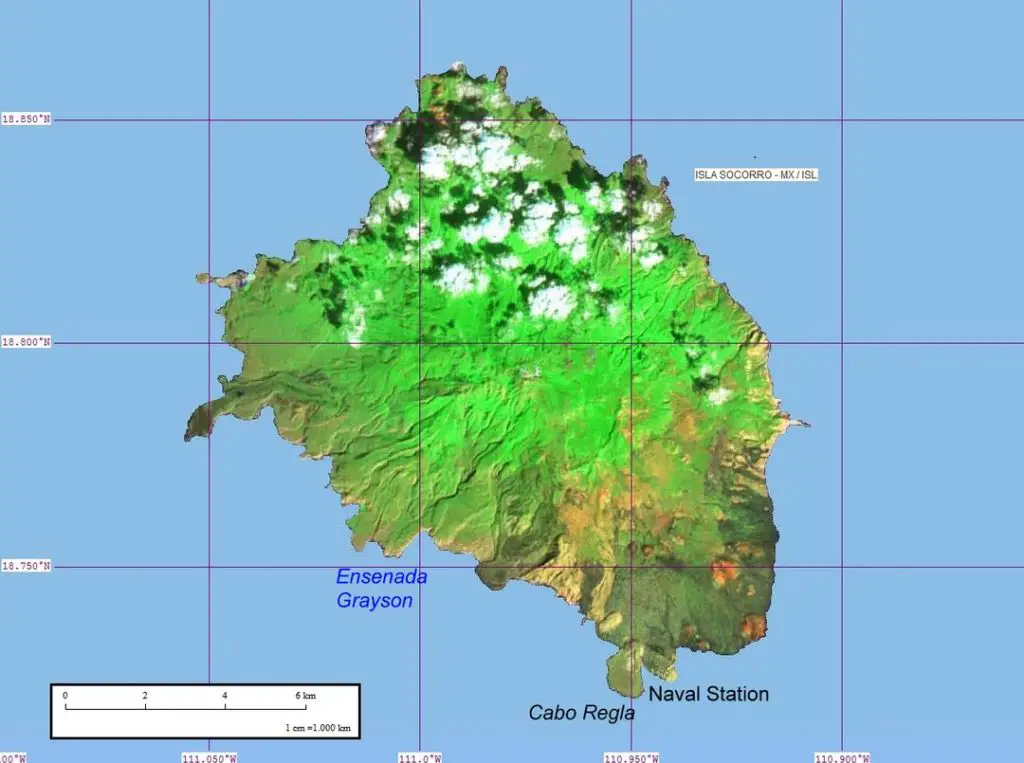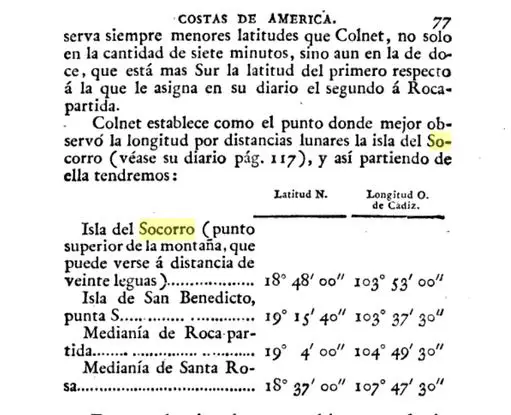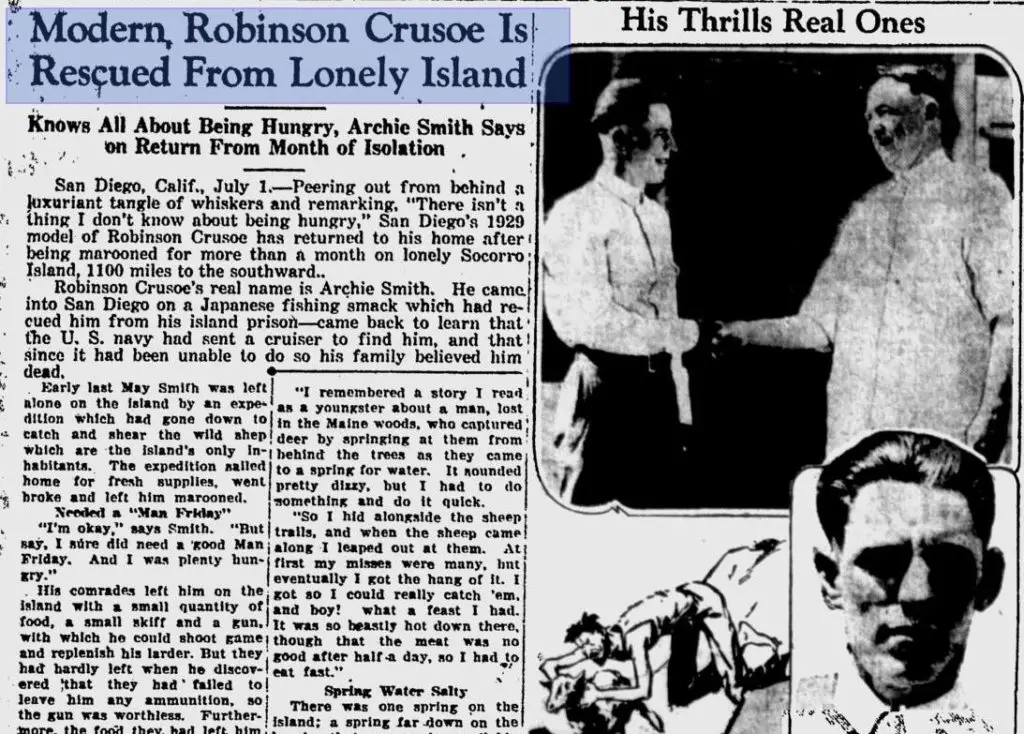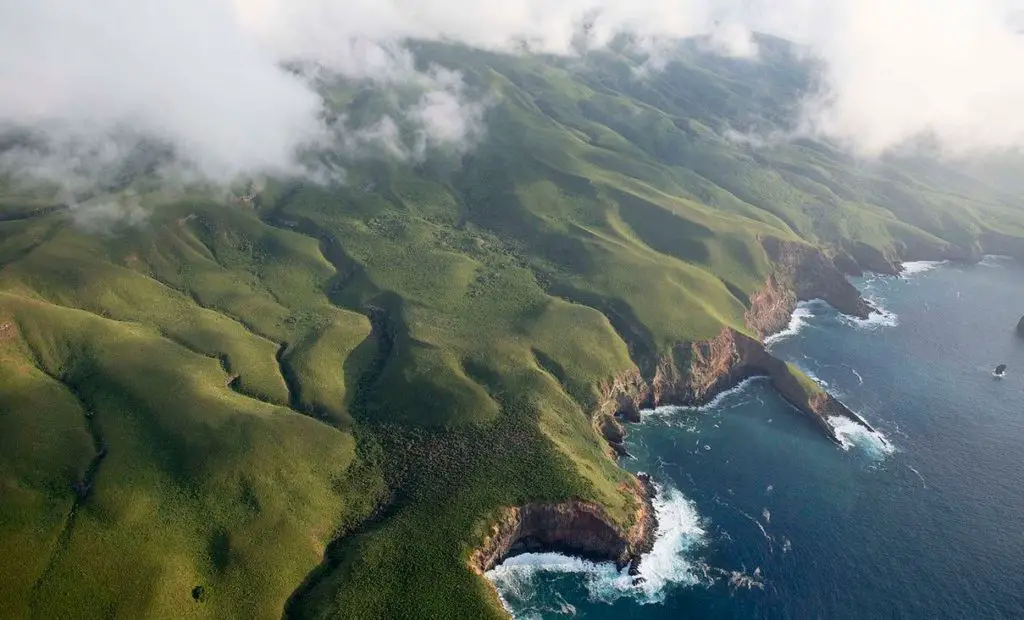Podcast: Play in new window | Download
Subscribe: Apple Podcasts | RSS
 On July 25, 1861, Mexican President Benito Juárez signed a decree awarding 4 small Pacific islands to the state of Colima. Located well off the continental shelf some 700 miles west of the Mexican mainland, these islands are collectively known as the Revillagigedo Archipelago, or in Spanish, Islas Revillagigedo. The four islands – Socorro, San Benedicto, Rocas Partidas and Clarión – are scattered across 260 miles of ocean. As is so in the 21st Century, when President Juárez made his decree, many Mexicans were not aware of the existence of these remote and obscure islands many hundreds of miles into the Pacific. Juárez had given this unorganized faraway Mexican territory to the state of Colima in hopes that the government of that state would develop Socorro Island into a penal colony. The island prison on Socorro was never built and successive governors of this tiny state had grand plans for the Islas Revillagigedo that never materialized. The archipelago was so far away, and as the popular phrase goes, out of sight, out of mind.
On July 25, 1861, Mexican President Benito Juárez signed a decree awarding 4 small Pacific islands to the state of Colima. Located well off the continental shelf some 700 miles west of the Mexican mainland, these islands are collectively known as the Revillagigedo Archipelago, or in Spanish, Islas Revillagigedo. The four islands – Socorro, San Benedicto, Rocas Partidas and Clarión – are scattered across 260 miles of ocean. As is so in the 21st Century, when President Juárez made his decree, many Mexicans were not aware of the existence of these remote and obscure islands many hundreds of miles into the Pacific. Juárez had given this unorganized faraway Mexican territory to the state of Colima in hopes that the government of that state would develop Socorro Island into a penal colony. The island prison on Socorro was never built and successive governors of this tiny state had grand plans for the Islas Revillagigedo that never materialized. The archipelago was so far away, and as the popular phrase goes, out of sight, out of mind.
For being off the beaten track, the Islas Revillagigedo has had an interesting history. Hernando de Grijalva discovered the islands on December 19, 1533, landing first on Socorro, the largest of the four, naming it Santo Tomás. Nine days later he landed on San Benedicto, about 25 miles to the north and named it Isla de los Inocentes in honor of the Holy Innocents whose feast day is December 28th. Grijalva missed Roca Partida and did not sail some 250 miles to the west to discover Clarión. The next person to visit the island group was Ruy López de Villalobos in 1542. Villalobos was the first to chart Roca Partida and then renamed Santo Tomás – which would later be Socorro – Anublada which loosely translates to “Foggy or Cloudy” owing to the dense cloud cover over the island’s volcano. Lonely Clarión Island was sighted by Villalobos on this 1542 voyage, and he named it Santa Rosa. The name of the island changed to Clarión in the early 1800s in honor of a Yankee brig that anchored offshore. Santo Tomás or Anublada Island was later given its current name of “Socorro” by Martín Yáñez de Armida who visited the island in 1608. He renamed it in honor of his wife. Sometime in the 1860s a passing ship let loose a flock of sheep on Socorro to provide food for future visiting seagoing vessels.
 The first explorers reported no signs of human habitation although some researchers theorize that these remote Pacific islands may have been visited by seafaring Polynesians centuries before the Spanish arrived. To many this is implausible because the closest inhabited islands, not including those immediately off the Mexican mainland, are over 2,500 miles away, the Marquesas in French Polynesia. After their discovery, the Revillagigedos were visited by many, from English and Dutch pirates to curious botanists and geologists. Over the centuries the islands never supported a permanent population owing to lack of stable fresh water sources. On Clarión there are two small freshwater ponds that may dry up in the summer and on Socorro there is a spring near the beach on the south part of the island that is exposed at low tide. Many buccaneers used the islands to hide out or to refresh their ships. A famous English pirate, George Shelvocke, captain of the Speedwell, was said to have frequented the islands quite often after preying on the Spanish galleons plying the Pacific in the early 1700s. Shelvocke’s Jolly Roger flag of a standing skeleton on a bright yellow background flew proudly over Socorro and Clarión Islands. The many caves on Socorro, especially on the western side of the island, led some to believe that pirates may have stashed their treasures there, fueled by tall tales and faded treasure maps of dubious origin. Surprisingly, over the years the islands have received few treasure hunters, probably owing to their remoteness and inaccessibility.
The first explorers reported no signs of human habitation although some researchers theorize that these remote Pacific islands may have been visited by seafaring Polynesians centuries before the Spanish arrived. To many this is implausible because the closest inhabited islands, not including those immediately off the Mexican mainland, are over 2,500 miles away, the Marquesas in French Polynesia. After their discovery, the Revillagigedos were visited by many, from English and Dutch pirates to curious botanists and geologists. Over the centuries the islands never supported a permanent population owing to lack of stable fresh water sources. On Clarión there are two small freshwater ponds that may dry up in the summer and on Socorro there is a spring near the beach on the south part of the island that is exposed at low tide. Many buccaneers used the islands to hide out or to refresh their ships. A famous English pirate, George Shelvocke, captain of the Speedwell, was said to have frequented the islands quite often after preying on the Spanish galleons plying the Pacific in the early 1700s. Shelvocke’s Jolly Roger flag of a standing skeleton on a bright yellow background flew proudly over Socorro and Clarión Islands. The many caves on Socorro, especially on the western side of the island, led some to believe that pirates may have stashed their treasures there, fueled by tall tales and faded treasure maps of dubious origin. Surprisingly, over the years the islands have received few treasure hunters, probably owing to their remoteness and inaccessibility.
The most famous story about the islands does not involve pirates, but a castaway American who enjoyed his 15 minutes of fame in the summer of 1929 when eager newspaper readers across the country devoured his story. His name was Archie Smith from San Diego, and he spent a month stranded alone on Socorro. Here is a newspaper article from The Bend Bulletin, out of Oregon, dated July 1, 1929:
 “Peering out from behind a luxuriant tangle of whiskers and remarking there isn’t a thing I don’t know about being hungry San Diego’s 1929 model of Robinson Crusoe has returned to his home after being marooned for more than a month on lonely Socorro Island 1100 miles to the southward.
“Peering out from behind a luxuriant tangle of whiskers and remarking there isn’t a thing I don’t know about being hungry San Diego’s 1929 model of Robinson Crusoe has returned to his home after being marooned for more than a month on lonely Socorro Island 1100 miles to the southward.
Robinson Crusoe’s real name is Archie Smith. He came into San Diego on a Japanese fishing smack which had rescued him from his island prison – came back to learn that the US Navy had sent a cruiser to find him and that since it had been unable to do so his family believed him dead.
Early last May Smith was left alone on the island by an expedition which had gone down to catch and shear the wild sheep which are the islands only inhabitants. The expedition sailed home for fresh supplies went broke and left him marooned.
‘I’m OK,’ says Smith, ‘but say, I sure did need a good Man Friday and I was plenty hungry.”
His comrades left him on the island with a small quantity of food a small skiff and a gun with which he could shoot game and replenish his larder, but they had hardly left when he discovered that they had failed to leave him any ammunition, so the gun was worthless. Furthermore, the food they had left him consisted only of a little flour and a few cans of beans.
‘The flour soon ran out and then I began to eat beans,’ he said. ‘And say I can sympathize now with the Navy and Army or anybody else who has to live on beans. I never got so tired of anything as beans in my whole life.
‘I decided one day that I would like to have some meat for a change but the problem was catching the wild sheep which roamed the island. These sheep were so wild that you couldn’t get within a mile of them, if they knew it. I had a gun but a lot of good it did me without any cartridges.
‘I remember a story I read as a youngster about a man lost in the Maine woods who captured deer by springing at them from behind the trees as they came to a spring for water. It sounded pretty dizzy but I had to do something and do it quick.
‘So, I hid alongside the sheep trails and when the sheep came along I leaped out at them. At first my misses were many but eventually I got the hang of it I got so I could really catch ‘em and boy! what a feast I had. It was so beastly hot down there though that the meat was no good after half a day and so I had to eat fast.’
There was one spring on the island: a spring far down on the beach that was only available at low tide. Consequently, it tasted pretty strongly of salt but Smith says he got used to that after the first few weeks.
‘During my stay on the island I had plenty of time for exploration,’ he says. ‘I covered almost every inch of it, too. The Navy reports that the island is only 10 miles long, but I’d say it’s more like 100 miles. There must be 2000 wild sheep there. Of course, I had agreed to stay as guard and help clean off the tough Mexican brush and build trails. If I ever needed a good man Friday. I needed him then. At the time I agreed to stay on I was pretty badly in need of money because of my family – and there was another baby coming – so I agreed to stay on the island and make something more.’
The expected baby that Smith mentions was born a short time after the Navy reported its cruisers unable to find Smith. The child was born dead.
Things are looking brighter for the family now. During Smith’s absence his wife and two small children were nearly destitute since the expedition that took him to Socorro Island went broke and they couldn’t get the pay that was due him. But their troubles are disappearing. In the first place, Mrs. Smith was so overjoyed to see her husband that she is willing to face almost any kind of future; and in addition, Deputy Labor Commissioner Stanley Gue says Smith will be able to collect every cent of back pay that is due him.
Smith’s plight attracted wide attention and the short time ago when he was still on the island, the Navy Department ordered a scout cruiser division to go to Socorro and rescue him but he had gone when the cruisers got there on June 10th and his wife gave him up for lost.
As it happened, however, a Japanese fishing boat had touched at the island two days before the cruisers arrived. It was a San Diego boat out for a catch of tuna fish it had run short of water and the skipper sent the boat ashore on Socorro to get some more.
 ‘Boy was I glad was I glad!’ says Smith. ‘I hope to tell you. And what a meal my first meal aboard that boat was!’
‘Boy was I glad was I glad!’ says Smith. ‘I hope to tell you. And what a meal my first meal aboard that boat was!’
Considering that he had lived for a month on beans and mutton that statement is easy to understand.
‘One or two boats passed the island, but none could see my signals,’ Smith said. ‘I waved to them but they kept on going.’
The Japanese vessel could not bring him back right away as it had not yet completed its catch of tuna. So it was that Smith’s return was delayed.
When he landed he had such a growth of beard that his friends did not recognize him so before he went to the hospital to see his wife he had a shave.
‘She won’t know me unless I get out from behind this underbrush,’ he said.
Hospital attaches declared that the reunion of ‘Mr and Mrs Robinson Crusoe’ was the happiest they had ever witnessed.”
End of article.
Since Smith’s abandonment on Socorro in 1929 the Mexican military has set up a permanent presence in this remote Pacific archipelago. In 1957, the government built a military base on the south side of Socorro which has been consistently populated by about 250 people including soldiers, family members and support staff. There is a small dock and runway to connect the settlement to the Mexican mainland. Faraway Clarión Island has a permanent military garrison of just nine soldiers living in barracks on the shores of Bahía Azufre. There are no tourist facilities on any of the islands, and tourism is discouraged. In fact, on November 24, 2017, Mexican President Enrique Peña Nieto established the largest protected marine area in the Americas around the Islas Revillagigedo encompassing some 57,000 square miles. Fishing, mining, and tourism development are restricted in this area and scientific research is tightly supervised. Many species of flora and fauna native to the archipelago are in danger of becoming extinct. If there is a trove of pirate treasures on these islands, no one will be able to find them, as Mexico tries desperately to preserve its remotest territory unknown to many far out in the Pacific.
REFERENCES
“Modern Robinson Crusoe is Rescued from Lonely Island,” In The Bend Bulletin, 1 Jul 1929.
Wikipedia
